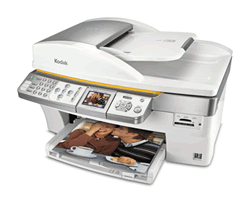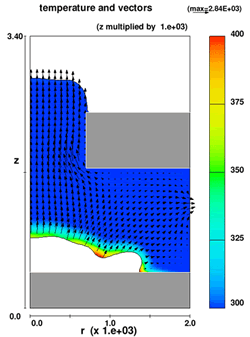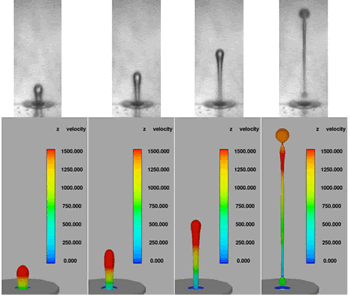When Eastman Kodak Company entered the inkjet printing market, the company had no time to waste. Kodak planned to make inroads in the business by using premium pigment-based inks to provide photo prints with vivid colors that last a lifetime and substantially reduce ink costs by incorporating the printhead into the printer rather than coupling it to the replacement ink cartridge. These advancements required the development of a totally new printhead. Industry experience has been that it typically takes 8 to 10 years to develop an all-new inkjet printer technology. Kodak researchers recognized that to meet the time constraints of the project, they needed both very accurate simulation software and a systematic method of optimizing their design. Using FLOW-3D and D-optimal designed experiments (DOE), Kodak researchers accomplished the task in only three years.
Innovative Ink Leads to New Printer Line
A key innovation that shaped Kodak’s EASYSHARE line of printers was the development of a pigment-based ink that provides the same level of brilliance as dye-based inks but which lasts much longer. Kodak engineers needed to develop a printhead that could deliver this new ink precisely onto the paper and other media while providing much longer life than existing printheads.
FLOW-3D has provided excellent qualitative agreement, based on visual observations, as well as good quantitative trend prediction. Just as important, the software accurately predicts design sensitivities. As a result, FLOW-3D has provided valuable insight in support of the advanced research and development activities at Kodak.
– Christopher Delametter, Senior Research Scientist, Eastman Kodak Company
Simulation Spotlight: Homogeneous Bubble Model
Kodak engineers accurately simulated the printhead operation using FLOW-3D, which incorporates a homogeneous bubble model that couples the formation of the vapor bubble to fluid and heat flow. A heat source within the thin-film stack is transported to the ink by conduction within the solid structure and by heat transfer at the fluid/solid interface. The vapor bubble forms explosively once the superheat temperature is reached in the fluid. The bubble is assumed to have homogeneous pressure and temperature, the dynamics of which are governed by the Clapeyron equation for the vapor. Mass and heat exchange at the vapor/liquid interface continues as the bubble expands, with the mass flux determined from kinetic theory. Surface tension and viscous forces are also included in the simulations. Proper representation of forces and fluxes in the model depends on accurate tracking of the free surface, which is achieved by employing the the TruVOF methodology and is a significant part of the calculations.
Design of Experiments
By using DOE to drive CFD, Kodak researchers were able to optimize the design of the printhead in considerably less time than competitors. The advantages of simulation were especially apparent late in the project when researchers discovered a more optimal ink formulation for one of the colors. The ink was quickly reformulated to capitalize on these advantages. But would it be necessary to spend a year or more redesigning the printhead? Fortunately, Kodak researchers had already run sensitivity studies on the ink properties, so without running a single additional simulation they quickly determined that the existing printhead design would work fine. The EASYSHARE family of printers was thus launched only three years after the project was initiated, in approximately one-third the amount of time typically required to bring new inkjet technology to market.
Learn more about the power and versatility of modeling microfluidic applications with FLOW-3D.



